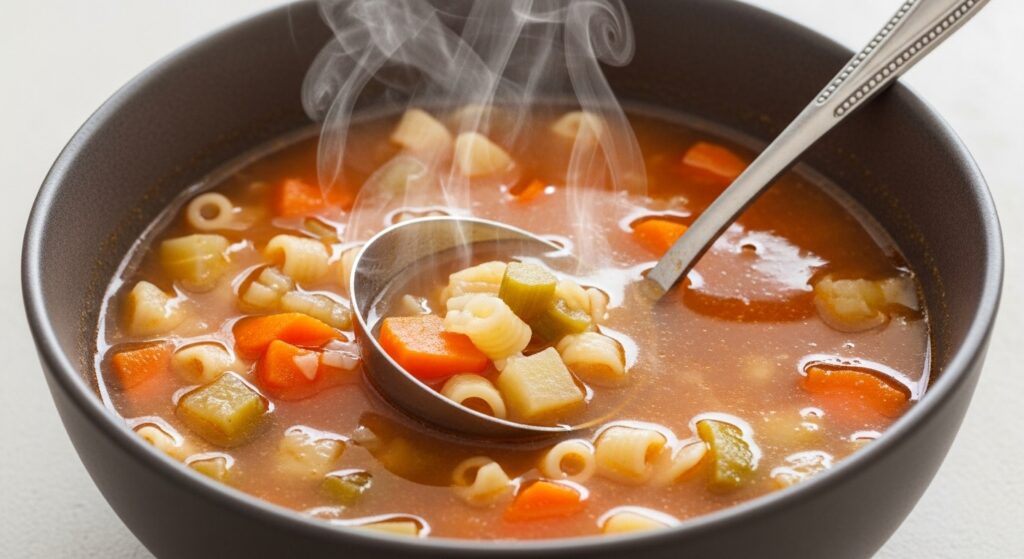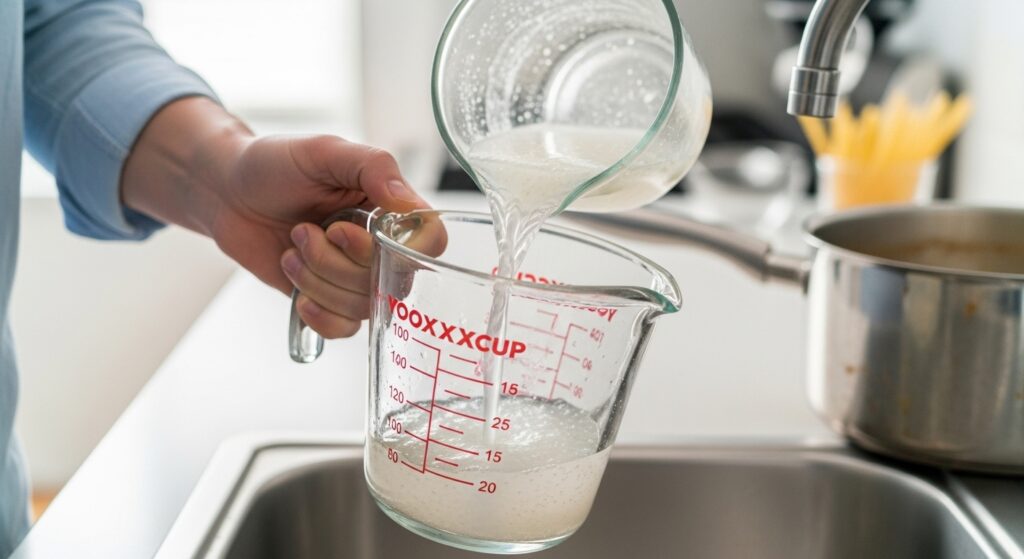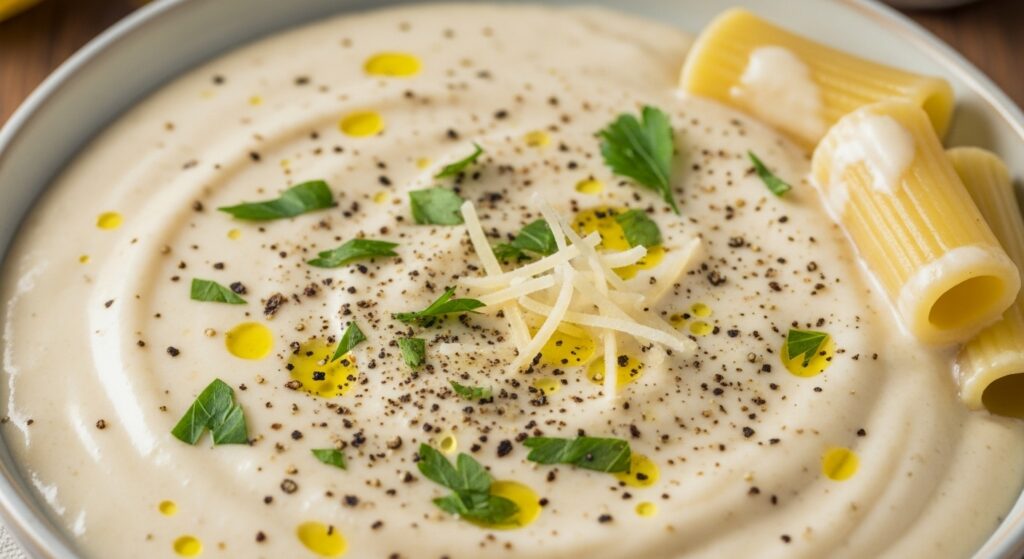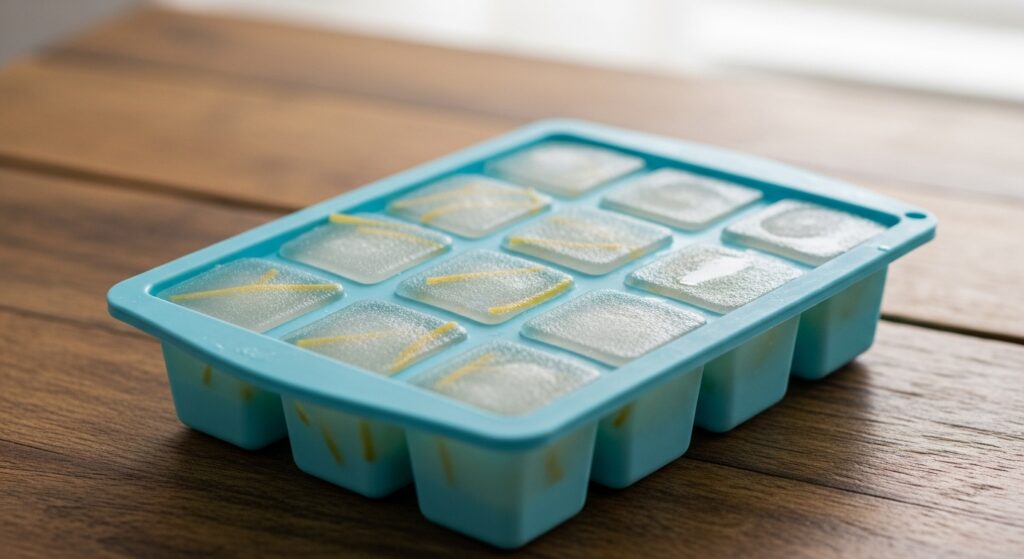
Blog Category: Zero-Waste & Budget Cooking
We’ve all done it. You drain a big pot of pasta, and a cloud of steam—and all that cloudy, starchy water—disappears right down the sink.
But what if I told you that water is one of the most valuable ingredients in your kitchen?
Here at Recipycle, we’re all about fighting food waste, and in my experience, throwing out pasta water is one of the biggest missed opportunities in home cooking. Chefs call it “liquid gold” for a reason. It’s the secret to restaurant-quality dishes, and it’s completely free.
Let’s break down exactly why you should be using leftover pasta water for sauces and soups and how to do it like a pro.
Quick Summary: Why Save Your Pasta Water?
Short on time? Here are the key takeaways for why that cloudy water is a kitchen powerhouse.
- It’s a Master Thickener: The water is full of starches released by the pasta. This starch acts like a natural cornstarch, adding body and thickness to any sauce or soup.
- It’s an Emulsifier: Starch is a classic emulsifier, which means it helps bind water and oil together. This is the secret to creating silky, non-greasy sauces that cling perfectly to your pasta.
- It Adds Flavor: You (hopefully) salted your pasta water! That seasoned water adds a subtle, savory depth to your final dish, meaning you may need less salt later.
- It’s the Ultimate Zero-Waste Hack: You’re turning a waste product into a valuable ingredient, stretching your food budget and making your meals taste better.

What Makes Pasta Water So Magical? The Science (Simplified)
Before we get to the how, let’s quickly cover the why. When you boil pasta, two key things happen:
- Starch Releases: The pasta releases starches into the water, making it cloudy and slightly viscous.
- Salt Infuses: The salt you added to the pot seasons the water.
This starchy, salty liquid is now a perfect binding and thickening agent. It’s the culinary glue that brings a dish together.
The #1 Best Use: Creating Silky, Restaurant-Quality Sauces
This is where pasta water truly shines. It’s the difference between a watery sauce that pools at the bottom of your bowl and a glossy sauce that coats every single piece of pasta.
1. Emulsifying Pan Sauces (The “No Cream” Cream Sauce)
This is my absolute favorite trick. For simple pan sauces like Cacio e Pepe, Carbonara, or a basic garlic and oil (Aglio e Olio), pasta water is not just an ingredient—it’s the essential ingredient.
- How to do it: Drain your pasta (reserving at least 1-2 cups of water!). Add the hot pasta directly to your pan with the other ingredients (e.g., cheese and pepper for Cacio e Pepe).
- The Magic: Add a splash (about 1/4 cup) of the hot pasta water and stir vigorously. The starch will “emulsify” the fats (from the cheese or oil) with the water, creating a stunningly creamy sauce with zero actual cream.
2. Thickening Tomato-Based Sauces
Ever feel like your jarred or homemade marinara is a bit too thin? Pasta water to the rescue.
- How to do it: Before your sauce is completely finished, add about 1/4 to 1/2 cup of the starchy water.
- The Result: Let it simmer for another 2-3 minutes. The sauce will thicken up beautifully, helping it cling to the spaghetti or penne instead of sliding off.
3. Making a Creamier, Brighter Pesto
Store-bought or homemade pesto can often be a bit “oily” and dense. What I’ve found works best is to thin it out with pasta water, not plain water or more oil.
- How to do it: In a large bowl, mix your pesto with about 1/4 cup of hot pasta water before adding the pasta. Toss everything together.
- The Result: The starchy water helps the pesto become a light, creamy sauce that coats the pasta evenly, rather than staying in oily clumps.

How to Use Leftover Pasta Water in Soups and Stews
This is the “Level 2” technique for using leftover pasta water for sauces and soups. It’s a fantastic way to add richness without adding fat.
4. Adding Body to Brothy Soups
If you’re making a vegetable soup, minestrone, or chicken noodle soup that feels a little thin, pasta water is your best friend.
- How to do it: Use the leftover pasta water as part of the broth. If your recipe calls for 6 cups of stock, try using 5 cups of stock and 1 cup of pasta water.
- Pro Tip: This works best when you’re adding small pasta (like ditalini or orzo) to the soup anyway. You can even cook the pasta in the soup, which releases the starches directly.
5. As a Savory Starter for Bean or Lentil Soups
When I’m making a hearty lentil, bean, or split pea soup, I often use leftover pasta water (even from the fridge!) as the base liquid along with my vegetable stock.
- Why it works: The salt and starch add a savory depth and a thicker, more satisfying mouthfeel to the final soup. It makes the soup feel richer and more comforting.
Pro-Tips for Saving and Storing Your “Liquid Gold”
You won’t always use the water right away. Here’s how to save it.
- The Easy Way: When draining, just place a heat-proof measuring cup or a small bowl in your sink under the colander to catch some of the water.
- The Pro Way: My preferred method is to skip the colander entirely. Use a spider strainer (a wide, wire-mesh scoop) to lift the pasta directly from the pot into your sauce pan. This leaves all the precious water behind, ready to use.
6. How Long Does Pasta Water Last in the Fridge?
You can store leftover pasta water in an airtight jar or container in the refrigerator for up to 3 days. It will thicken as it cools, which is perfectly normal. Just give it a good shake before using.
7. Can You Freeze Pasta Water? (Yes!)
This is the ultimate zero-waste hack.
- How to do it: Pour cooled pasta water into a silicone ice cube tray and freeze.
- Why it’s genius: Once frozen, pop the cubes into a freezer bag. The next time you’re making a quick pan sauce or a single serving of soup, just toss in a “pasta water cube”! It’s perfectly portioned and ready to go.

Other Surprising Ways to Use Leftover Pasta Water
While our focus is on sauces and soups, that’s not all it’s good for!
- Baking Bread or Pizza Dough: Use it in place of plain water in your next pizza or focaccia recipe. The starches can help create a tender crumb and a crispier crust.
- Cooking Beans or Grains: Use it to cook dried beans, lentils, or rice to add a little extra flavor and body.
- Watering Your Plants (With a Big Warning!): This only works if you used UNSALTED pasta water. If you salted your water (which you should have!), the salt will harm your plants. But if you happened to boil pasta without salt, your houseplants will love the starchy, mineral-rich drink.
Frequently Asked Questions (FAQ)
Q1: Does it matter what kind of pasta I use?
Yes, somewhat. Bronze-die cut pastas and whole wheat pastas tend to release more starch, giving you a cloudier, more potent “liquid gold.” But honestly, any pasta water is better than no pasta water.
Q2: How much pasta water should I add to my sauce?
Always start with less than you think you need.
My rule of thumb is to add 1/4 cup at a time, stirring vigorously to see how it thickens. It’s easy to add more, but impossible to take it out.
Q3: Can I use pasta water if I added oil to the pot?
First, pro-tip: stop adding oil to your pasta water! In my experience, it doesn’t really stop pasta from sticking (stirring does that) and it can make the pasta slick, preventing your beautiful sauce from clinging. If you did use oil, you can still use the water, but it may not emulsify quite as well.
Q4: Should I use pasta water from “one-pot” pasta recipes?
In a one-pot pasta, the pasta cooks in the sauce, so all that starchy goodness is already released directly into your final dish. That’s exactly why those recipes work so well—they’re built around this “liquid gold” principle from the start!
Conclusion: Stop Draining, Start Saving!
Using leftover pasta water is one of the easiest, fastest, and most effective ways to level up your cooking and embrace a zero-waste kitchen. It’s not waste; it’s a powerful ingredient that costs you absolutely nothing.
You’ll get creamier sauces, richer soups, and the satisfaction of knowing you’re making the most of every ingredient. This is what Recipycle is all about.
Now I want to hear from you! What’s your favorite way to use leftover pasta water? Do you have another “liquid gold” hack I missed? Leave a comment below and let’s talk!
